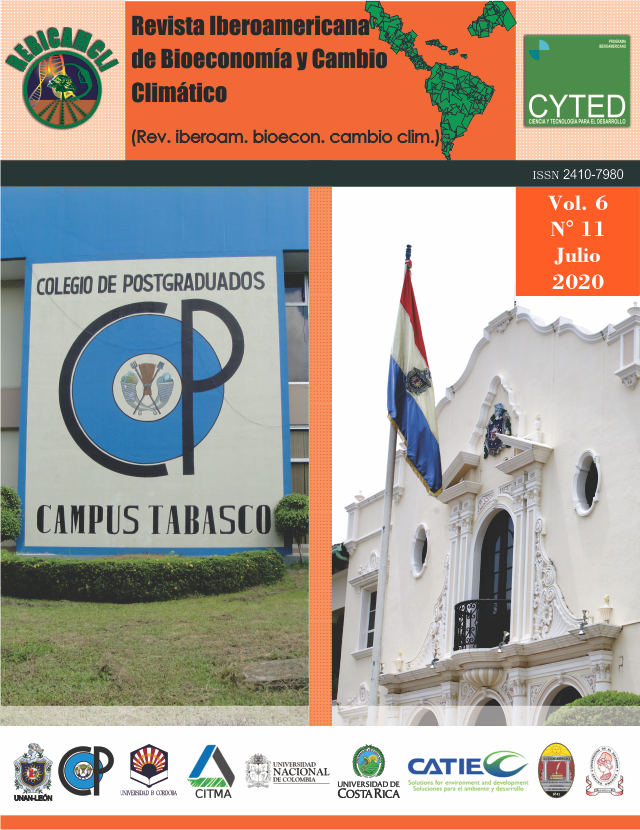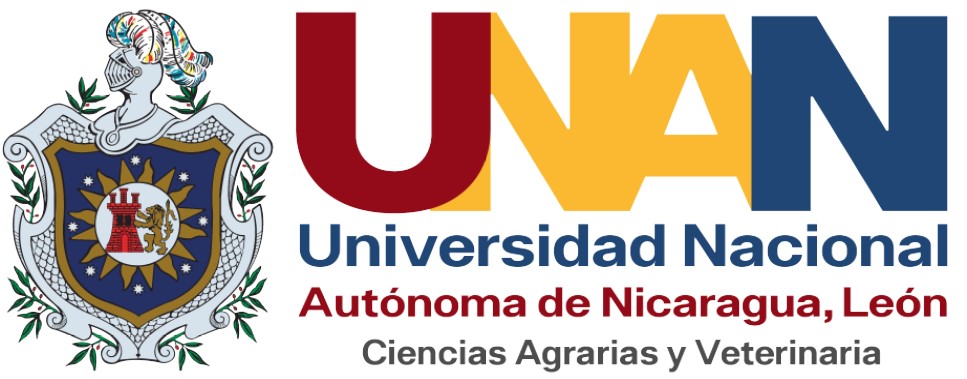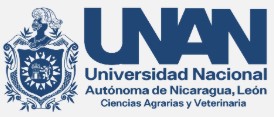Change of soil use and climate variability in Chiautzingo, Puebla, Mexico
DOI:
https://doi.org/10.5377/ribcc.v6i11.9421Keywords:
Environmental degradetion, Perception, Forest areaAbstract
The modification of the vegetal cover It´s obvious and increasing, the main causes are the different socioeconomic activities that the population develops. Climate is an essential factor in the distribution of biotic patterns of ecosystems and, in the same sense, ecosystems, through their cover, can influence climate variability. Studies that consider the change in land use, vegetation and climate are relevant to determine processes related to soil degradation, loss of biodiversity and climate variability. This study analyzed the change in land use and climate variability from 1984 to 2018 in the municipality of Chiautzingo, Puebla, Mexico from Landsat satellite images in Geographic Information Systems. Historical data from three weather stations were analyzed and through a survey of producers, information was collected on the perception of both the phenomenon of land use change and climate variability. The change in land use is related to the loss of forest area, with an annual exchange rate of -0.57%. The increase in the area devoted to protected agriculture was 310.58 hectares, which puts pressure on biotic and abiotic resources. It was also found that there is climatic variability, which is perceived by the population. It is necessary to have this analysis to identify the areas that have the greatest environmental degradation, and as a basis for planning the use and management of natural resources.
Downloads
Metrics
References
Córdoba, V. C. y León, S.T. 2013. Resiliencia de sistemas agrícolas ecológicos y convencionales frente a la variabilidad climática en Anolaima (Cundinamarca - Colombia). Universidad Nacional de Colombia.
FAO. 1998. Encuestas agrícolas con múltiples marcos de muestreo: Programa de encuestas agropecuarias basadas en diseños de muestreo con marco de área o doble marco de elección de área y de lista. 2 10. pp.1-32
FAO. 2010. Evaluación de los recursos forestales mundiales 2010. Términos y definiciones. Documento de trabajo 144/s. Roma.
Organización de las Naciones Unidas para la Agricultura y la Alimentación (FAO) y JRC. 2012. Cambio de uso de las tierras forestales mundiales 1990-2005. Documento Forestal 169 FAO. Organización de las Naciones Unidas para la Agricultura y la Alimentación y Centro Común de Investigación de la Comisión Europea. Roma, FAO.
Gómez, A., R. 1970. Introducción al muestreo. Tesis de Maestría en Ciencias en Estadística. Centro de Estadística y Cálculo. Colegio de Postgraduados. Chapingo, México.
Instituto Nacional de Estadística y Geografía (INEGI). 2010. Prontuario de información geográfica municipal de los Estados Unidos Mexicanos. Chiautzingo, Puebla [en línea]. Clave geoestadística 21001. Disponible en: http://www.inegi.org.mx
Instituto Nacional de Estadística y Geografía (INEGI). 2016. Anuario estadístico y geográfico de Puebla. México: INEGI. 952 p. ISBN 978-607-739-987-2 [en línea]. Disponible en: http://www.inegi.org.mx.
Instituto Nacional de Estadística y Geografía (INEGI). 2010. Manual para la Difusión y Aplicación de la Norma Técnica sobre Domicilios Geográficos. Dirección general de geografía y medio ambiente. Aguascalientes, Ags.
Intergovernmental Panel on Climate Change (IPCC). 2000. Land Use, Land-Use Change, and Forestry. Special Report of the Intergovernmental Panel on Climate Change [Watson, R.T., I.R. Noble, B. Bolin, N.H. Ravindranath, D.J. Verardo y D.J. Dokken (eds.)]. Cambridge University Press, Cambridge, Reino Unido y Nueva York, NY, Estados Unidos de América, 377 p.
Lambin, E. 1997. Modelling and monitoring land-cover change processes in tropical regions. Progress in Phisycal Geography. 21(3). pp.375-393
Mas, J., Velázquez, A. y Couturier, S. 2009. La evaluación de los cambios de cobertura/uso del suelo en la República Mexicana. Investigación ambiental. 1(1). pp. 23-39
Ministerio del ambiente. 2010. Proyecto de Adaptación al Cambio Climático a través de una efectiva gobernabilidad del agua en Ecuador. Gobierno de Ecuador.
López, V., Balderas, P., Chávez, M., Juan, P. y Gutiérrez C. 2015. Cambio de uso de suelo e implicaciones socioeconómicas en un área mazahua del altiplano mexicano. CIENCIA Ergo Sum, 22 (2): pp. 136-144
Rivera, B., Aceves, L. A., Arrieta, A., Juárez, J. F., Méndez, J. M. y Ramos, C. 2016. Evidencias del cambio climático en el estado de Tabasco durante el periodo 1961-2010. Rev. Mex. Cienc. Agríc vol.7 spe 14 Texcoco feb./mar. 2016.
Rodríguez, A. 2007. Cambio climático agua y agricultura. Dirección de Desarrollo Rural Sostenible-IICA. Edición N.1. II Etapa.
Secretaria de Medio Ambiente y Recursos Naturales (SEMARNAT). (2014). Diagnóstico del Programa de Manejo de Tierras para la Sustentabilidad Productiva. Dirección General del Sector Primario y Recursos Naturales Renovables, Ciudad de México, México.
Velázquez, A., Mas, J. F., Díaz, G. J. R., Mayorga, S. R., Alcántara, P. C., Castro, R., Fernández, T., Bocco, G., Ezcurra, E., Palacio, J. L. 2002. Patrones y tasas de cambio de uso del suelo en México. Gaceta Ecológica, núm. 62, 2002, 21-37 pp. Secretaría de Medio Ambiente y Recursos Naturales Distrito Federal, México.
Downloads
Published
How to Cite
License
Copyright (c) 2020 Ibero-american JournalL of Bioeconomy and Climate Change e-ISSN 2410-7980

This work is licensed under a Creative Commons Attribution-NonCommercial-ShareAlike 4.0 International License.
Copyright © 2025 Rev. iberoam. bioecon. climate change. National Autonomous University of Nicaragua León (UNAN-León), Knowledge Area of Agrarian and Veterinary Sciences / Specific Area of Agroecology and Agribusiness / Center for Research in Agrarian Sciencies. Academic Directorate. Research Department. Publication and scientific events Unit.












 EDITORIAL
EDITORIAL e-ISSN
e-ISSN


 COPYRIGHT
COPYRIGHT This work is licensed under a Licencia Internacional
This work is licensed under a Licencia Internacional 












